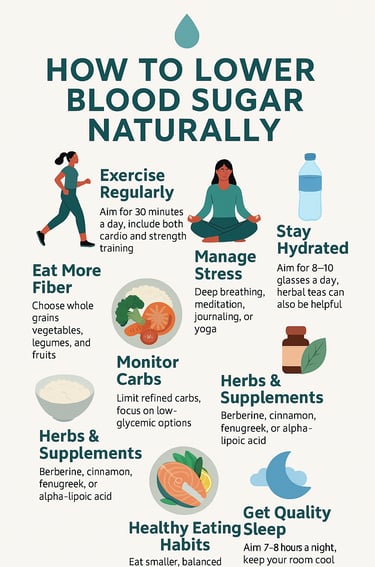Stay updated on what is trending in health. Discover tips and resources for a healthier, balanced life.
How to Lower Blood Sugar Naturally: 7 Science-Backed Ways
Discover 7 proven ways to lower blood sugar naturally—backed by science and easy to follow. From diet tips to stress relief, take control of your health one step at a time.
WELLNESS
Dr. S. Ali
7/18/20256 min read


Managing blood sugar naturally isn’t just about skipping dessert—it’s about making consistent, smart choices that help your body thrive. Whether you're dealing with prediabetes, type 2 diabetes, or simply trying to stay balanced, there are science-supported strategies that really work. Let’s dig into seven natural methods that can help you lower blood sugar and feel more energized throughout your day.
1. Move Your Body—But Make It Fun
Why it works: Physical activity helps muscles use glucose for energy, reducing sugar levels in your bloodstream. Plus, it boosts insulin sensitivity, meaning your body can manage blood sugar more efficiently—even hours after you’ve exercised.
What to do:
Aim for at least 30 minutes of moderate exercise most days of the week. Even short bursts throughout your day count—think 10-minute chunks that add up! Regular movement improves your body's ability to use insulin effectively.
Try walking, swimming, dancing—even gardening. The key is consistency and enjoyment. Pick activities you actually look forward to. When it feels like fun instead of a chore, you’re more likely to make it a lasting habit.
After meals, a short walk can prevent post-meal sugar spikes. Just 10–15 minutes can make a big difference by helping your muscles soak up glucose. It’s like giving your body a gentle nudge in the right direction.
2. Eat Balanced, Fiber-Rich Meals
Why it works: Fiber slows sugar absorption and keeps blood sugar steady. It also feeds your gut bacteria, which play a role in glucose metabolism. Pairing fiber with protein and healthy fats can prevent blood sugar spikes and crashes.
Foods to focus on:
Non-starchy vegetables like broccoli, spinach, and bell peppers These fiber-rich veggies are low in carbs and high in nutrients, making them perfect for keeping blood sugar in check. Plus, they’re super versatile—roast, sauté, or toss them raw into a salad!
Legumes (lentils, beans, chickpeas) Packed with protein and soluble fiber, legumes help slow down digestion and prevent sudden sugar spikes. They also keep you feeling full for longer, which can curb unnecessary snacking.
Whole grains such as oats and quinoa Unlike refined grains, whole grains have their fiber intact, which helps stabilize glucose levels. Oats make a hearty breakfast, while quinoa is a protein-rich base for lunch bowls or dinner sides.
Nuts and seeds These little nutrient powerhouses are full of healthy fats, magnesium, and fiber—all great for blood sugar control. A handful of almonds or a sprinkle of chia seeds can be a simple upgrade to any meal.
Bonus tip: Combining healthy fats and lean protein with complex carbs can soften the sugar surge.
3. Manage Stress—Your Blood Sugar Notices
Why it works: Stress releases hormones like cortisol, which can spike blood sugar. Chronic stress can also increase insulin resistance over time. Relaxation techniques like deep breathing, meditation, or a walk in nature can help keep both your mind and your glucose levels in balance.
Stress-busting ideas:
Deep breathing or meditation Just a few minutes of focused breathing can calm your nervous system and lower stress hormones. Meditation apps or simply sitting in quiet stillness can help reset your mind and blood sugar levels.
Journaling or reading Writing down your thoughts helps you process emotions and release tension. And losing yourself in a good book can offer a peaceful escape—like a vacation for your brain.
Yoga or tai chi These gentle movement practices combine physical activity with mindfulness, which supports both mental clarity and glucose control. Bonus: they’re great for flexibility and balance too!
Laughing with friends (yes, this counts!) Laughter reduces stress hormones like cortisol and triggers the release of feel-good chemicals. It’s a natural mood booster that also promotes social connection—which is healing in its own right.
4. Stay Hydrated Like a Pro
Why it works: Water helps your kidneys flush excess sugar through urine. Staying well-hydrated also supports circulation and may improve insulin sensitivity. Aim for water over sugary drinks, which do the opposite of what your blood sugar needs.
How much to drink:
Aim for 8–10 glasses a day, more if you're active or in a hot climate. Staying hydrated helps your kidneys flush out excess sugar more efficiently. If you’re sweating a lot or soaking up sun, be sure to sip even more to stay balanced and energized.
Herbal teas and water-rich fruits like cucumber and watermelon also count. Unsweetened herbal teas can be soothing and hydrating, while juicy fruits sneak hydration into your snacks. It’s a tasty way to support your blood sugar goals without feeling like you're guzzling plain water all day.
Pro tip: Avoid sugary drinks and sodas—they raise blood sugar in a flash.
5. Embrace Natural Herbs and Supplements
Why it works: Some herbs have compounds that improve insulin sensitivity. Cinnamon, berberine, fenugreek, and bitter melon are among the most researched. Always talk to your doctor before starting supplements, especially if you're on medication.
Top contenders:
Berberine: Known for its blood sugar-lowering properties Derived from plants like barberry and goldenseal, berberine has been shown to improve insulin sensitivity and help regulate glucose metabolism. It’s even been compared to some diabetes medications in clinical studies—without the harsh side effects.
Cinnamon: May reduce fasting glucose A warm, flavorful spice that goes beyond taste—cinnamon contains bioactive compounds that can mimic insulin and enhance its effects. Sprinkling a dash into oatmeal, smoothies, or tea is a delicious way to potentially support sugar control.
Fenugreek: Contains soluble fiber and helps regulate sugar These nutty-flavored seeds slow down carbohydrate digestion thanks to their mucilaginous fiber. Fenugreek may also stimulate insulin production, making it a popular choice in traditional remedies.
Alpha-lipoic acid: A powerful antioxidant shown to support glucose uptake Found in foods like spinach and broccoli—or available as a supplement—ALA helps cells absorb glucose more efficiently. It also protects against oxidative stress, which is often elevated in people with blood sugar imbalances.
Always talk to your doctor before adding supplements to your routine!
6. Rethink Meal Timing and Portion Sizes
Why it works: Overeating or irregular meals can spike or crash sugar levels. Eating smaller, balanced meals at regular intervals helps maintain stable blood glucose throughout the day. Consider early dinners and avoiding late-night snacking for better overnight control.
Strategies:
Eat smaller, balanced meals throughout the day Keeping meals light and steady helps prevent major blood sugar swings and keeps your energy up. Think protein, fiber, and healthy fats with each plate to stay fuller longer and avoid cravings.
Avoid heavy late-night meals Your body winds down in the evening, so big meals can linger longer and disrupt glucose regulation. Try to wrap up dinner at least two hours before bed and opt for something light if you need a snack.
Practice mindful eating—slow down and savor your food Chew slowly, appreciate the flavors, and tune into hunger and fullness cues. Eating with intention can help avoid overeating and reduce stress, both of which support steady sugar levels.
7. Prioritize Sleep Like It's Your Superpower
Why it works: Poor sleep can mess with insulin sensitivity and increase cravings for sugary foods. Even one night of sleep deprivation can raise blood sugar levels. Aim for 7–9 hours of quality sleep to support hormone balance, appetite control, and overall metabolic health.
Sleep tips:
Aim for 7–8 hours of quality sleep nightly Sleep isn’t just rest—it’s repair. Consistent, deep sleep helps regulate hormones like insulin and cortisol that play a role in blood sugar levels. Think of it as your nightly recharge ritual.
Stick to a consistent bedtime Your body loves rhythm. Going to bed and waking up at the same time—even on weekends—supports your circadian clock, which helps keep metabolism and appetite more stable.
Keep your bedroom cool, dark, and tech-free Light and electronics disrupt melatonin production, your sleep-friendly hormone. A quiet, cozy sleep space promotes faster, deeper rest—so consider blackout curtains, white noise, and a phone-free zone.
A quick but crucial note:
While these natural strategies can greatly support your blood sugar health, they are not a substitute for prescribed medications. If your doctor has recommended medication, it's because your body needs additional help managing glucose levels. Lifestyle changes can complement medical treatment—but they shouldn't replace it unless your healthcare provider says otherwise. Always talk to your doctor before making changes to your treatment plan. Your safest and most effective path to better health is one that combines professional guidance with daily habits that support healing.
Final Thoughts
Lowering blood sugar naturally isn’t about perfect choices—it’s about consistent, intentional ones. Think of each day as an opportunity to nourish your body with movement, good food, rest, and calm.
Small steps—like choosing fiber-rich meals, staying active, or getting better sleep—can make a big difference over time.
Your body is always working to find balance, and your daily habits can either support or strain that effort.
Progress doesn’t have to be dramatic to be meaningful. Even tiny changes add up when practiced regularly.
Be kind to yourself on this journey—wellness is a long game, not a quick fix.
And remember: your health is not just about numbers—it’s about feeling strong, focused, and in control of your life.
Just don’t forget—if you’re on medication, these natural tools are meant to support, not replace, your treatment. Always follow your doctor’s advice.
Sources:
WHO – Diabetes Fact Sheet
https://www.who.int/news-room/fact-sheets/detail/diabetesMayo Clinic – Diabetes Diet: Create Your Healthy-Eating Plan
https://www.mayoclinic.org/diseases-conditions/diabetes/in-depth/diabetes-diet/art-20044295Harvard Health – Healthy Eating for Blood Sugar Control
https://www.health.harvard.edu/diseases-and-conditions/healthy-eating-for-blood-sugar-controlHarvard T.H. Chan School of Public Health – Carbohydrates and Blood Sugar
https://nutritionsource.hsph.harvard.edu/carbohydrates/carbohydrates-and-blood-sugar/ ·National Institute of Diabetes and Digestive and Kidney Diseases (NIDDK) – Diabetes Overview & Management
https://www.niddk.nih.gov/health-information/diabetes/overview/preventing-problems
Pulse Your Health
Empowering you to achieve your health goals.
Contact
© 2025. All rights reserved.
Disclaimer: The content on this website is for informational purposes only and is not medical advice. Always seek the advice of your physician or other suitably qualified healthcare professional for diagnosis, treatment and your health related needs.
